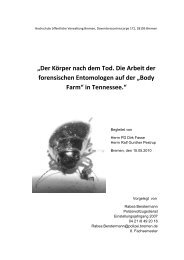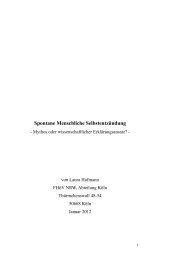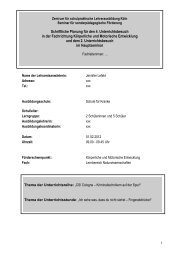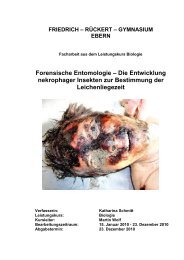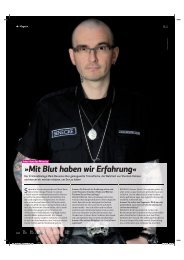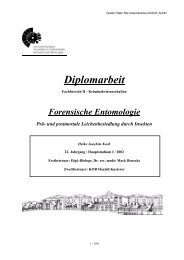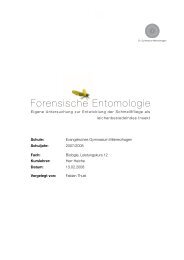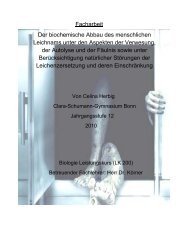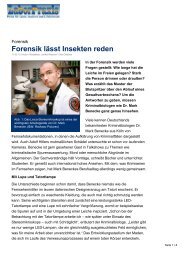A brief survey of the history of forensic entomology - Wiki2.benecke ...
A brief survey of the history of forensic entomology - Wiki2.benecke ...
A brief survey of the history of forensic entomology - Wiki2.benecke ...
Create successful ePaper yourself
Turn your PDF publications into a flip-book with our unique Google optimized e-Paper software.
28 MARK BENECKE<br />
Meanwhile, turn-<strong>of</strong>-<strong>the</strong>-century France and<br />
Germany enjoyed a general increase in interest<br />
in zoological studies including invertebrate<br />
life. As evidence, we see <strong>the</strong> great success <strong>of</strong><br />
two popular book series from that time, “A.<br />
BREHMs Thierleben“ (BREHM 1876-1879, Fig.<br />
10), and even more “J. H. FABRE’s Souvenirs<br />
entomologiques” (FABRE 1879-1909) with its<br />
German edition (FABRE 1908-1910; see Fig.<br />
11), among o<strong>the</strong>r topics specifically dealing<br />
with carrion beetles and blow flies. These<br />
books, still well-known to <strong>the</strong> public in Central<br />
Europe, inspired an interest in <strong>entomology</strong><br />
in large numbers <strong>of</strong> people. Among <strong>the</strong><br />
lasting benefits <strong>of</strong> this popularity are numerous<br />
ecological studies that continue to be<br />
drawn upon in <strong>forensic</strong> case studies today.<br />
In 1907, C. MORLEY published an article in<br />
England dealing with <strong>the</strong> question <strong>of</strong> what<br />
species should be classified as carrion beetles.<br />
He stated that during ten years <strong>of</strong> collecting<br />
he found that winter was “almost <strong>the</strong> best<br />
time” for carrion beetles and that <strong>the</strong>re are<br />
(so-called) carrion beetles that are not carnivorous<br />
but “act as final dissolvers to <strong>the</strong> ancient<br />
carcasses. (...) it is still a mystery to me what<br />
N[ecrophorus] vespillo feeds upon.” Papers like<br />
this were <strong>the</strong> early basis for <strong>the</strong> systematic<br />
ecological studies that have influenced <strong>forensic</strong><br />
<strong>entomology</strong> since <strong>the</strong> 1920’s. In 1912,<br />
<strong>the</strong>re was even a paper presented at <strong>the</strong> German<br />
Society for Forensic Medicine (ANONY-<br />
MUS 1912), and in 1919, <strong>the</strong>re was even a report<br />
by HUNZIKER dealing with <strong>the</strong> fauna and<br />
flora found in graves in Basel (Switzerland).<br />
6. Circa <strong>the</strong> World Wars<br />
Beginning in <strong>the</strong> 1920s, species lists and<br />
monographs on <strong>forensic</strong>ally important insects<br />
Fig. 11: HENRI FABRE popularized <strong>the</strong> life <strong>of</strong> arthropods in his “Souvenirs entomologiques“. Here a<br />
German edition <strong>of</strong> his books. Note pictures <strong>of</strong> carrion-feeding insects on <strong>the</strong> covers (from FABRE<br />
1908-1910).<br />
Abb. 11: HENRI FABRE popularisierte die Biologie von Arthropoden mit seinen „Souvenirs entomologiques“.<br />
Hier eine deutsche Ausgabe; auf den Titelseiten finden sich sogar Abbildungen von Aas<br />
fressenden Insekten (aus FABRE 1908-1910).



